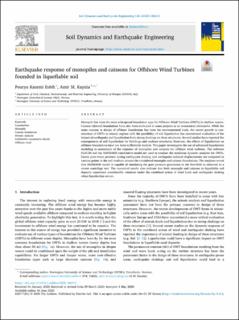Earthquake response of monopiles and caissons for Offshore Wind Turbines founded in liquefiable soil
Peer reviewed, Journal article
Published version

View/
Date
2020Metadata
Show full item recordCollections
- NGI articles [1061]
Original version
10.1016/j.soildyn.2020.106213Abstract
Monopile has been the most widespread foundation type for Offshore Wind Turbines (OWTs) in shallow waters. Caisson (skirted) foundations have also been evaluated in some projects as an economical alternative. While the main concern in design of offshore foundations has been the environmental loads, the recent growth in construction of OWTs in seismic regions with the possibility of soil liquefaction has necessitated evaluation of the impact of earthquake and liquefaction from strong shakings on these structures. Several studies have reported the consequences of soil liquefaction for buildings and onshore structures; However, the effects of liquefaction on offshore foundations have not been sufficiently studied. This paper investigates the use of advanced liquefaction modeling in assessment of the response of monopiles and caissons for offshore wind turbines. The software FLAC3D and the SANISAND constitutive model are used to conduct the nonlinear dynamic analyses for OWTs. Excess pore water pressure during earthquake shaking and earthquake-induced displacements are computed at various points in the soil medium around the considered monopile and caisson foundations. The analyses reveal that SANISAND model is capable of simulating the pore pressure generation in the free-field as observed in a recent centrifuge test. The numerical results also indicate that both monopile and caissons in liquefiable soil deposits experience considerable rotations under the combined action of wind loads and earthquake shaking when liquefaction occurs.